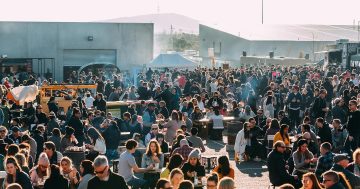
SuperSky Engineering co-founder Dr James Gilbert (left) and BentSpoke co-founder Richard Watkins (right) launch a high-altitude balloon on its space mission to find yeast. Photo: BentSpoke Brewing Co.
One small flight for a balloon, one giant leap for beer lovers everywhere.
BentSpoke Brewing Co has recently gone where no brewery dared go before – to collect yeast from space to brew the aptly named Astro Beer.
The out-of-this-world expedition was all thanks to a partnership between the Canberra brewery and Australian aerospace company SuperSky Engineering, and a National Science Week grant from Inspiring Australia.
It’s the first time a brewery has ever gone this far into space to try to collect a sample of yeast to be used in a beer, and the BentSpoke team knew the odds of success were low.

And it’s up, up and away for the high-altitude balloon and its yeast collecting mission. Photo: BentSpoke Brewing Co.
It all began in Temora, NSW, with the launch of a high-altitude balloon loaded with a custom-made petri dish contraption that would act as a source for the yeast to latch onto.
When the balloon made it to the stratosphere – somewhere between 23km and 30km above earth – the trapdoor on the petri dish was opened to try to collect a yeast sample.
At such altitudes, the low temperature, low pressure and high ultraviolet radiation levels are very similar to the conditions on Mars.
It took the balloon about two-and-a-half hours to complete its mission, before re-entering the earth’s atmosphere and landing around 140km east of Temora.
Upon landing, the balloon was taken back to the BentSpoke brewery in Mitchell where a single yeast deposit was extracted, combined with a number of elements to ensure its safety and growth, and eventually used in a new brew.
For BentSpoke co-founder and head brewer Richard Watkins, and SuperSky Engineering co-founder Dr James Gilbert, it was an opportunity to push the boundaries of beer.
James is not only one of Australia’s most innovative engineers, he is also an amateur brewer, and says it’s great to be able to use science to spark a conversation with the public.
“I’ve wanted to try this for years so it was great to find the right people to make it happen were here in the ACT all along,” says James.
According to James, it’s been a great way to show people that science and engineering form the basis of so many everyday things – including food and drink – and National Science Week (14-22 August) is an apt time to show this.
“Of course, this was an extreme example, but it’s a cool way of getting people thinking,” he says.
James knew all along that collecting a sample of yeast wasn’t going to be easy, and he says he’s amazed they managed to pull it off the first time because it required so many elements coming together and working.
“In the end, we had a single window of a few hours to launch the balloon due to the jet stream blowing very strongly from the west,” he says.
“With National Science Week approaching, we had to move really quickly and we literally only got one shot, although we originally thought we’d need several tries.”

Richard Watkins (left) and Dr James Gilbert (right) share a beer after their hard work. Photo: BentSpoke Brewing Co.
James says the difficulty with space expeditions is there isn’t much on-the-ground testing you can do with little equipment.
“The odds are also against us because we already know that the yeast that we could collect only exists in very small quantities,” he says.
“So at the end of the day this was a fishing trip with not many fish.”
James says the wind might have been in their favour, although he’s not entirely sure.
He’s yet to try the beer, and is excited to see just how all of their hard work has paid off.

















